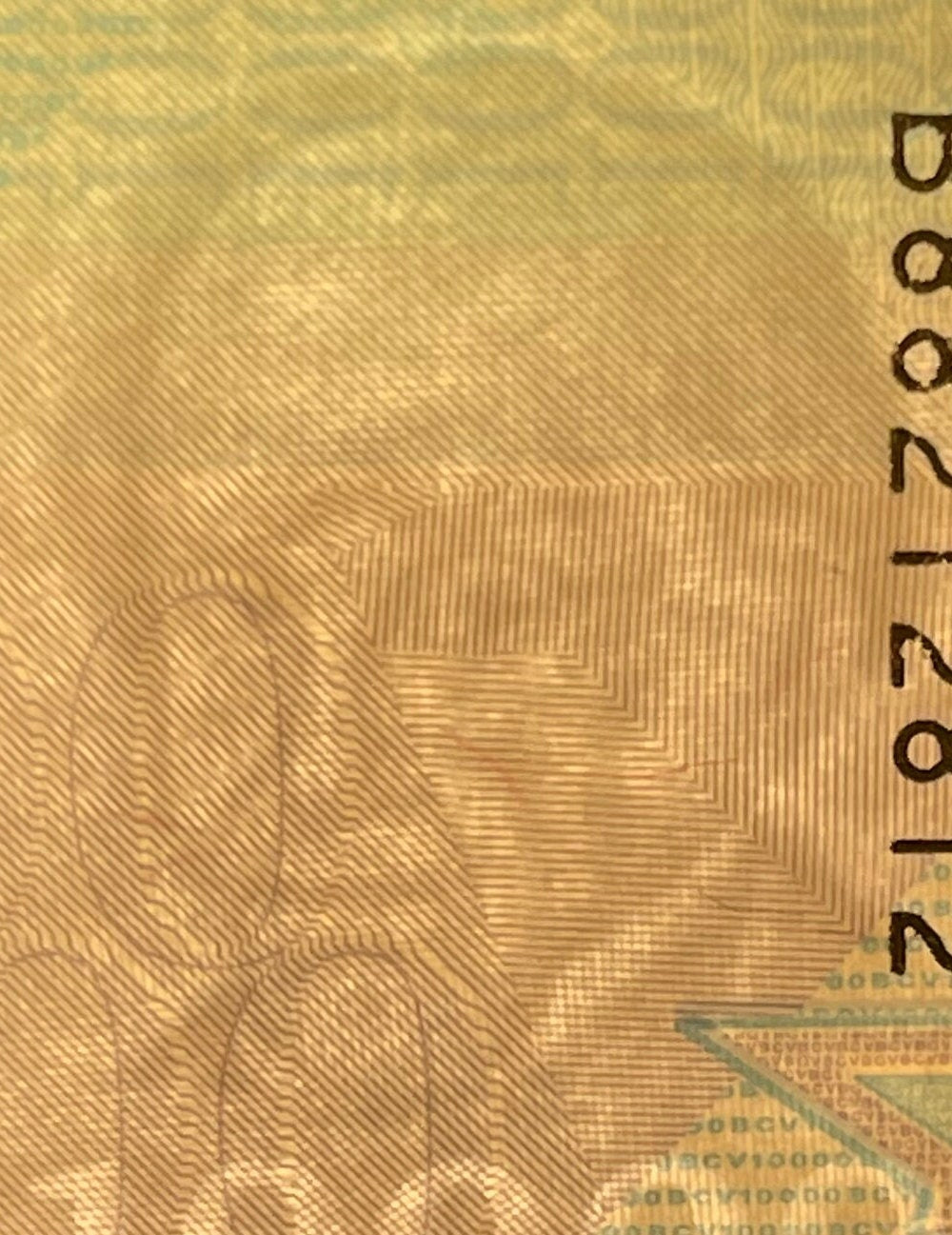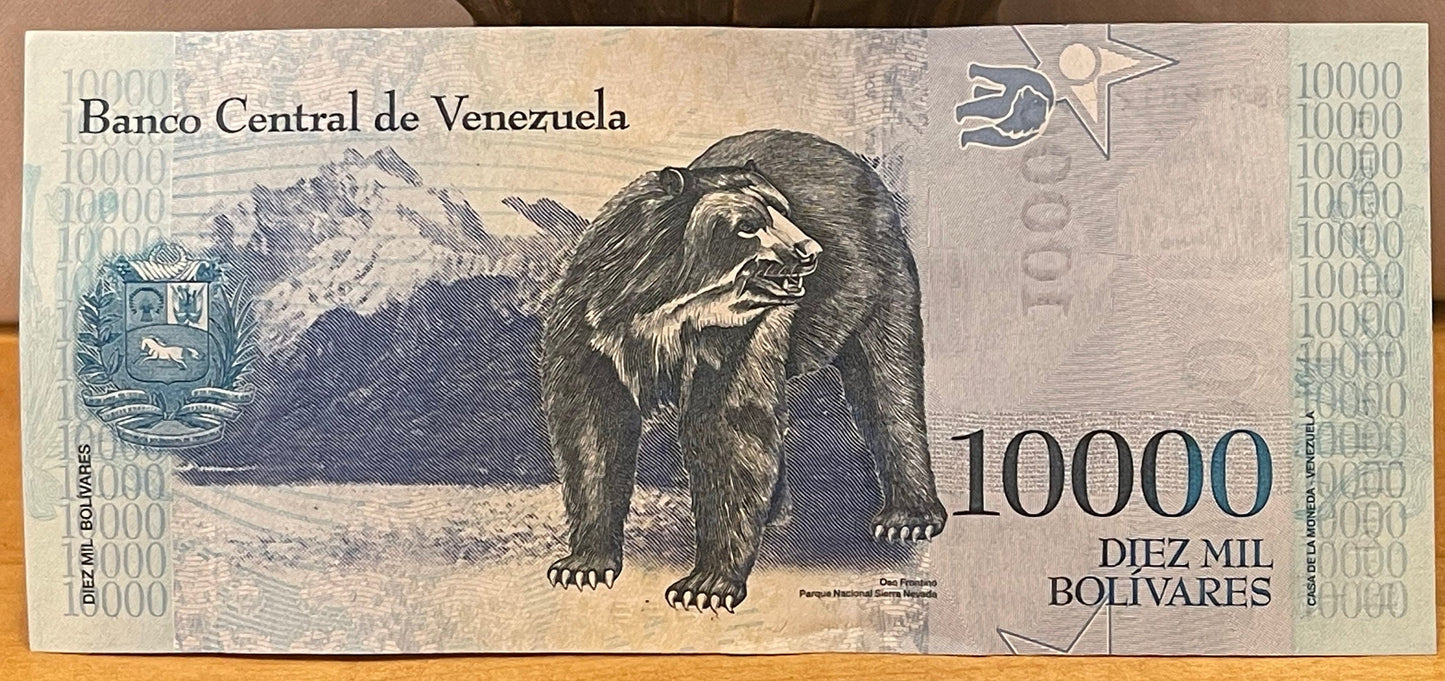elemintalshop
Andean Spectacled Bear & Philosopher Simón Rodríguez 10,000 Bolívares Venezuela Authentic Banknote Money for Jewelry and Collage (Educator)
Andean Spectacled Bear & Philosopher Simón Rodríguez 10,000 Bolívares Venezuela Authentic Banknote Money for Jewelry and Collage (Educator)
Couldn't load pickup availability
Andean Spectacled Bear & Philosopher Simón Rodríguez 10,000 Bolívares Venezuela Authentic Banknote Money for Jewelry and Collage (Educator)
Obverse: Simón Rodríguez, Venezuelan philosopher and educator, notably Simón Bolívar's tutor and mentor.
Lettering: República Bolivariana de Venezuela
10000
DIEZ MIL BOLIVARES
PAGADEROS AL PORTADOR EN LAS OFICINAS DEL BANCO
PRESIDENT PRIMER VICEPRESIDENTE BCV
Translation: Bolivarian Republic of Venezuela
TEN THOUSAND BOLIVARS
PAYABLE TO BEARER IN THE BANK OFFICES
PRESIDENT FIRST VICE PRESIDENT BCV
Reverse: Spectacled bear, Mountains of Sierra Nevada National Park.
Coat of Arms of Venezuela.
Lettering: Banco Central de Venezuela 10000
Oso Frontino
Parque Nacional Sierra Nevada
DIEZ MIL BOLIVARES
CASA DE MONEDA - VENEZUELA
Translation: Spectacled Bear
Sierra Nevada National Park
Central Bank of Venezuela
10000
TEN THOUSAND BOLIVARES
CURRENCY HOUSE - VENEZUELA
Watermark: Simón Rodríguez with numeral 10000 below
Features
Issuer Venezuela
Issuing bank Central Bank of Venezuela
Period Bolivarian Republic (1999-date)
Type Standard banknote
Years 2016-2017
Value 10,000 Bolívares (10 000 VEF)
Currency Bolívar Fuerte (2008-2018)
Composition Paper
Size 157 × 69 mm
Shape Rectangular
Demonetized 5 December 2018
Number N# 205368
References P# 98
Wikipedia:
The spectacled bear (Tremarctos ornatus), also known as the Andean bear, Andean short-faced bear, or mountain bear and locally as jukumari (Aymara and Quechua), ukumari (Quechua) or ukuku, is the last remaining short-faced bear (subfamily Tremarctinae). Its closest relatives are the extinct Florida spectacled bear, and the giant short-faced bears of the Middle to Late Pleistocene age (Arctodus and Arctotherium). Spectacled bears are the only surviving species of bear native to South America, and the only surviving member of the subfamily Tremarctinae. The species is classified as Vulnerable by the IUCN because of habitat loss.
Perception of the Andean bear
There are two views of the Andean Bears. One is ex-situ, people that live far from where the bears inhabit; for them, the spectacled bears are usually charismatic symbols of the wilderness, animals that are not aggressive and that are mainly vegetarians. The other view is in-situ, people that live in areas where the bears inhabit; for them, bears are cattle predators, pests that should be killed as a preventative measure and where any cattle loss is immediately attributed to them, becoming persecuted and hunted. Therefore, understanding the real conflict extent and the intensity of people’s perception of the conflict is important to assess correctly the issue. Also, environmental education campaigns are a must to change these public perceptions of the Andean bear as predator.
Cultural importance of the Andean bear
The Andean bear is of great importance to indigenous nationalities, especially from the highlands, although it is also known by the Achuar, Cofán, Kichwa and Shuar Amazonian indigenous nationalities.
There are several myths and legends about this species; many relate its strength, its solitary character and its apparent shyness to highlight characteristics of certain local leaders. In several stories from indigenous populations, the conflict between bears and human beings is already narrated, making them look like the beasts that destroy crops; on the other hand, the Shuar consider that the Andean bears should not be touched and, even worse, a child should touch them since that means death.
Depending on the area, it has received various names, the most common being the spectacled bear, although it is also known as cariblanco, negro, anteojudo and bestia, to name a few. It also has a name in several indigenous languages; "in Achuar Chicham (Achuar language) it is called Chayú; in A'ingae (Cofán language) it is called Ocomari; in Kichwa language it is known as Ukumari, Yana Puma, Yana Usu, or Uturunku, depending on the region or the Kichwa people; In the Pai Cocä language (Secoya people) it is called Kina Take; while in the Shuar Chicham language (Shuar people), the bear is called Chái, Sanchipin Chái, Cheiva or Chiánkrap".
******
Wikipedia:
Simón Rodríguez (October 28, 1769, Caracas, Venezuela – February 28, 1854, Amotape, Peru), known during his exile from Spanish America as Samuel Robinson, was a Venezuelan philosopher and educator, notably Simón Bolívar's tutor and mentor.
In May 1791, the Caracas Council (Cabildo) gave him a position as teacher in the "Reading and Writing School for Children". In 1794, he presented his critical writing Reflection on the flaws vitiating the Reading and Writing School for Children in Caracas and Means of Achieving its Reform and a New Establishment to the council, which represented an original approach to a modern school system.[citation needed] His role in the failed Gual and España conspiracy against the Spanish crown in 1797 forced him to leave Venezuela.
In Kingston, Jamaica he changed his name to Samuel Robinson, and after staying some years in the United States he traveled to France (1801). There, in 1804, he met his former protégé, Simón Bolivar; together they made a long journey across Europe. They witnessed the coronation of Napoleon Bonaparte in Milan, as King of Italy and in Rome, witnessed how Bolívar took his famous oath that he would liberate all of America from the Spanish Crown, and registered it for history: "I swear before you; I swear on my parent’s God; I swear on them; I swear on my honor; and I swear on my Motherland; that I won’t give rest to my arm, nor repose to my soul, until I have broken the chains that oppress us by will of the Spanish power."
Rodríguez returned to America in 1823, using his name "Simón Rodríguez" again. In Colombia he established the first workshop-school in 1824. He was called to Peru by Simón Bolívar and became "Director for Public Education, Physical and Mathematical Sciences and Arts" and "Director of Mines, Agriculture and Public Roads" of Bolivia.
In 1826, Rodríguez established a second workshop-school, as part of a project for all Bolivia. But Antonio José de Sucre, president of Bolivia since October 1826, did not have a good relationship with him, and Rodríguez resigned the same year, working during the rest of his life as educator and writer, living alternatively in different places of Peru, Chile and Ecuador. His work Sociedades Americanas (American Societies) was divided in several issues and published in Arequipa (1828), in Concepción (1834), Valparaíso (1838), and Lima (1842).
Last years and legacy
Most of Rodríguez's written works remained in Guayaquil, Ecuador, but were lost in the large city fire of 1896. Rodriguez is the face on the 50 Bolivar Fuerte bills. He was also the face in the old 20,000 Bolívar bills (until 2007). One of the Bolivarian Missions of Hugo Chávez, Mission Robinson, is named for him.
*******
Wikipedia:
The current coat of arms of Venezuela was primarily approved by the Congress on April 18, 1836, undergoing small modifications through history, reaching the present version.
The coat of arms was established in the Law of the National Flag, Shield and Anthem (Ley de Bandera, Escudo e Himno Nacionales), passed on February 17, 1954, by the military governor of Venezuela, Marcos Pérez Jiménez. The shield is divided in the colors of the national flag. In the dexter chief, on a red field, wheat represents the union of the 20 states of the Republic existing at the time and the wealth of the nation. In sinister chief, on a yellow field, weapons (a sword, a sabre and three lances) and two national flags are tied by a branch of laurel, as a symbol of triumph in war. In base, on a deep blue field, a wild white horse (representing Simón Bolívar's white horse Palomo) runs free, an emblem of independence and freedom.
Above the shield are two crossed cornucopias (horns of plenty), pouring out wealth. The shield is flanked by an olive branch and another of palm, both tied at the bottom of the coat with a large band that represents the national tricolour (yellow for the nation's wealth, blue for the ocean separating Venezuela from Spain, and red for the blood and courage of the people). The following captions appear in golden letters on the blue stripe:
19 de Abril de 1810 (April 19, 1810) 20 de Febrero de 1859 (February 20, 1859)
Independencia (Independence) Federación (Federation)
República Bolivariana de Venezuela (Bolivarian Republic of Venezuela)
Share



















